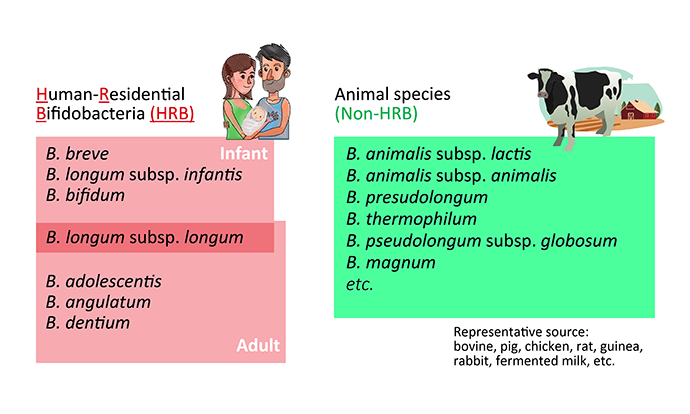What are HRB?
Bifidobacteria: HRB or Non-HRB species?
The Story of Human-Residential Bifidobacteria (HRB)

The genus Bifidobacterium is currently composed of approximately 80 species, including 11 subspecies. Among them, only a few of these are common inhabitants of human gut, and these species of human origin are grouped as Human-Residential Bifidobacteria (HRB).
Meanwhile, other species which are the natural inhabitants of animal or environment are referred to as non-HRB; such as B. animalis subsp. animalis, B. animalis susbp. lactis, B. pseudolongum, etc. It is noted that B. animalis subsp. lactis was not frequently detected in human guts and their ages were restricted. Although B. animalis subsp. lactis is thought to be not feasible for using a wide variety of carbon resources in the human gut environment, its wide use as probiotics in commercial dairy products might affect the detection after weaning.
It is widely recognized that the health-promoting traits of bifidobacteria are strain-specific. However, accumulating evidence suggests that bifidobacterial species of different residential origins display differences in their physiological features and functions in human health. Current research has demonstrated the differential physiological features of HRB and non-HRB such as metabolic capability, meanwhile comparative and functional genomic investigations have revealed the genetic attributes of bifidobacteria, which may explain their colonization affinities in the human gut.
Distribution of Bifidobacterium Species in Human Gut
The Proportions of Bifidobacterium Species Vary with Ageing
One study investigating the sequential changes in the composition of Bifidobacterium species in 441 healthy Japanese subjects over a wide range of ages, from zero to 104 years old revealed clear differences in the proportions and types of Bifidobacterium species in the gut microbiota between infants, adults, and the elderly.

A widespread species at all ages
B. longum subsp. longum was widely detected in all segmented age groups ranging from newborns to centenarians, for which some strains were shown to be genetically equipped to utilize both plant-derived and human milk oligosaccharides (HMO)-derived sugars.

A common member of infant gut microbiota
B. breve was more commonly detected in infants. The cell numbers of B. breve decrease with aging.
B. animalis subsp. lactis

Might not a species of human gut microbiota
B. animalis subsp. lactis, which is not considered to be a species of human gut microbiota, was also detected in 11.4% of human subjects, for which its detection was restricted to individuals after weaning to less than 80 years old. B. animalis subsp. lactis is predicted to have a limited number of carbohydrate utilization pathways/enzymes, it seems to be unsuitable for using the carbon resources in the human gut environment.
